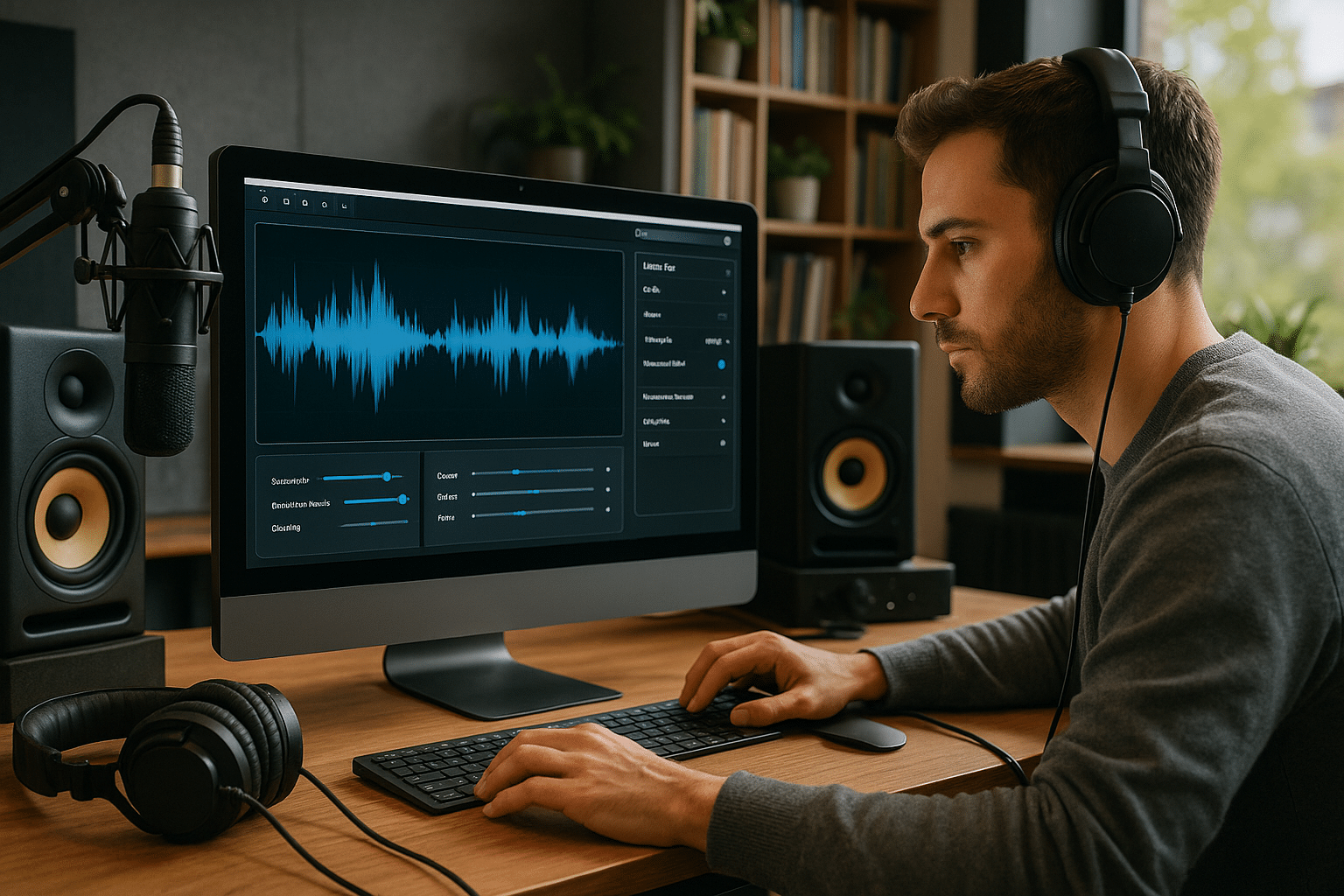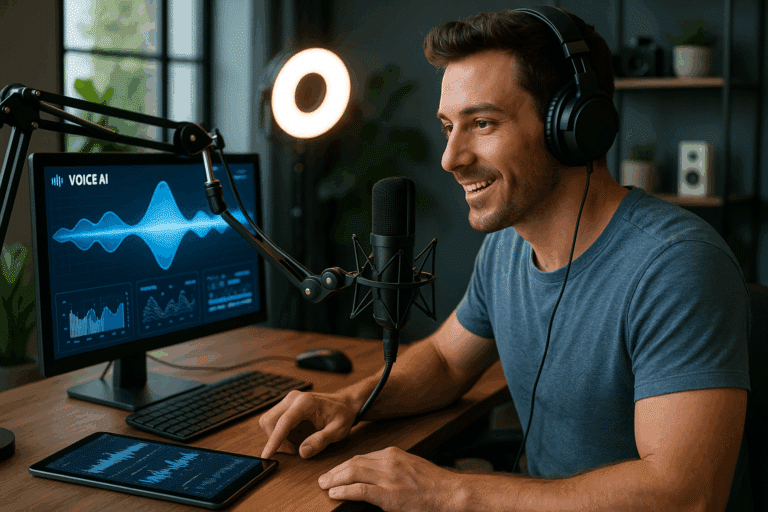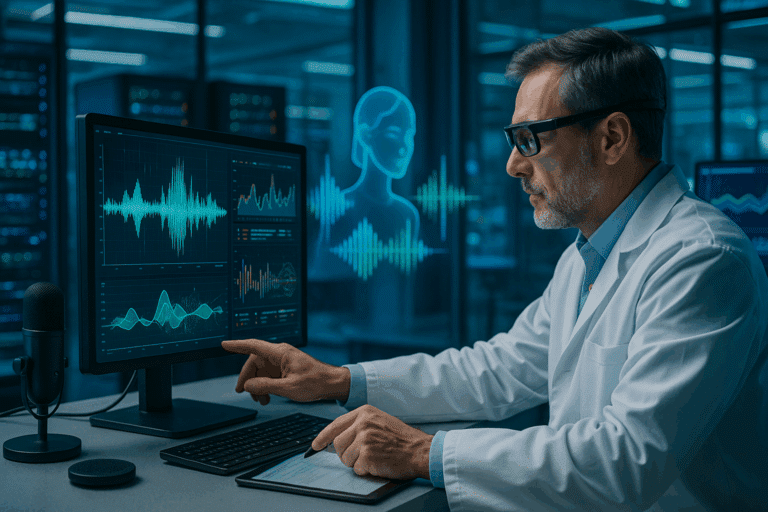Whether you’re a musician, filmmaker, podcaster, or a sound engineer, you’ve probably encountered the painstaking task of cleaning up audio recordings. Even the smallest hiss, hum, or pop can disrupt the listener’s experience, diverting their attention from your content. But what if I told you that you could revolutionize your sound with the help of Artificial Intelligence (AI)? 🎧🎶💡
Indeed, AI technology has infiltrated nearly every industry, reshaping traditional methods and injecting efficiency and accuracy where it is needed the most. The realm of audio recording is no exception. From noise reduction and sound enhancement to transcription and sound design, AI is set to disrupt the audio industry. But how does it work? What potential does it hold for the future? And how can you master the art of cleaning audio recordings using this technology? If these are the questions that resonate in your mind, you’ve come to the right place.👌👍
In this comprehensive guide, we will dive deep into the world of AI technology in audio recording. Prepare to unravel the mechanisms behind AI-powered audio cleaning, learn about the tools and applications that harness its potential, and discover how you can revolutionize your sound. By the end of this article, not only will you have a deeper understanding of AI technology in audio recording but you will also be equipped with the knowledge to utilize it effectively in your audio projects. 🎹🔊🚀
Embarking on a Sonic Journey: The Intersection of AI and Audio Recording
Imagine a world where flawless audio recording is achievable at the click of a button, without the need for expensive gear or professional studios. A world where you can focus on the creative aspects of your craft, leaving the technical difficulties to be tackled by an intelligent system. This is not a distant future. It is the reality that AI technology is shaping for audio recording. Whether you are a seasoned audio professional or a beginner finding your footing, the advent of AI is poised to augment your audio recording experience. 🌍🔮🔧
Behind the Scenes: Demystifying the Mechanics of AI in Audio Recording
At its core, AI in audio recording revolves around machine learning algorithms that are trained to identify and remove unwanted sounds. From background noise and echoes to pops and clicks, these intelligent algorithms can discern and tackle a wide array of audio imperfections. But how does AI distinguish between the sound of a guitar strum and a disruptive hum? What makes it a reliable tool for audio cleaning? In this section, we will unveil the inner workings of AI in audio recording, providing you with a solid foundation to leverage its capabilities. 🎚️🎛️🤖
Tools of the Trade: Mastering AI-Powered Audio Cleaning Applications
From software plugins to standalone applications, a multitude of AI-powered tools are available in the market that promise to clean up your audio recordings. But which ones live up to their claims? How do you choose the right tool for your needs? And how can you make the most of these applications? Stay tuned as we explore the landscape of AI-powered audio cleaning tools, their features, and how to use them effectively. 📲💻🛠️
Get ready to revolutionize your sound with AI technology. Embark on this sonic journey with us as we navigate through the noise and echo towards clear, captivating audio. Your listeners deserve nothing less than the best. And with the power of AI, that’s exactly what you’ll deliver. 🎤🌟🎉
Unleashing the Power of AI for Cleaner Audio Recordings
Have you ever grappled with the challenge of getting rid of background noise in your audio files? You’re not alone. Many audio professionals struggle with achieving clean audio recordings, particularly in challenging environments. That’s where Artificial Intelligence (AI) comes into play. AI technology, with its machine learning algorithms, can be a game-changer in your quest for crisp, clear audio recordings. Let’s dive into the heart of this fascinating topic.
AI is no longer a figment of our imaginations from sci-fi movies. It’s here, and it’s revolutionizing numerous industries, including the audio recording industry. AI algorithms have the ability to analyze and identify various elements in an audio file, separate them, and clean the audio to a degree that was unimaginable a few years ago. By utilizing machine learning and pattern recognition, AI can help you remove unwanted background noise, improve speech clarity, and even restore old recordings.
This is a boon for professionals in the audio industry, whether they’re podcasters, audio engineers, musicians, or filmmakers. But even if you’re just a casual user who wants to improve your Zoom calls or home videos, the benefits of AI in audio cleaning can be substantial. Now, let’s understand how exactly this technology works.
Demystifying the Magic: How Does AI Clean Audio Recordings?
At its core, AI works by training algorithms with vast amounts of data. In the case of audio cleaning, this data comprises various types of sounds, noise, and speech. Over time, the AI learns to recognize these elements and can then distinguish between them in an audio file.
Once the elements are identified, the AI can isolate and remove the unwanted noise, leaving behind only the clean audio. But the magic doesn’t stop there. Advanced AI models can even predict and regenerate parts of the audio that might have been lost or distorted due to the noise, resulting in even clearer and more coherent audio.
To visualize this process better, let’s take the example of an AI-powered software called Krisp. It uses a Deep Neural Network (DNN) trained with over 20,000 different noise types and 50,000 clean speech samples. When Krisp encounters an audio file, it can identify and remove the noise, while preserving the speech, all in real time. For a more in-depth understanding of how Krisp works, check out this video on the Krisp official YouTube channel titled “How Krisp Works – Noise Cancelling App”.
Comparing AI Audio Cleaning Tools: Which One Should You Choose?
Given the increasing prominence of AI in audio cleaning, several tools are available today that employ this technology. But how do you choose the right one for your needs? To help you with this, we’ve created a comparative table of some of the top AI audio cleaning tools available in the market. Remember to consider factors such as ease of use, functionality, pricing, and customer reviews before making your choice.
| Tool | Features | Pricing |
|---|---|---|
| Krisp | Real-time noise cancellation, integration with over 800 apps, HD Voice | Free version available, Pro version at $20/month |
| iZotope RX 8 | Advanced audio repair and enhancement, Spectral Recovery, Wow & Flutter correction | Starts from $99 |
| Audionamix XTRAX STEMS | Automatic stem separation, customizable separation balance | $99 |
| Acon Digital Restoration Suite 2 | Four audio restoration and noise reduction plugins, easy to use, high precision algorithms | $99.90 |
Enhancing Your Skills: Learn to Master AI Audio Cleaning
Now that you have a basic understanding of AI in audio cleaning and have compared different tools, it’s time to enhance your skills. Fortunately, there are numerous online resources available to help you master the art of AI audio cleaning.
Several YouTube tutorials provide step-by-step guidance on how to use these tools effectively. For instance, the video titled “Tutorial: How to Remove Background Noise with Krisp” on the Krisp YouTube channel provides a comprehensive guide to using Krisp for audio cleaning. Similarly, the iZotope channel has numerous videos on using RX 8 to clean and enhance audio files.
Online courses and webinars can also be a valuable resource. Platforms like Coursera and Udemy offer courses on audio engineering and AI, which can help you understand the underlying technology better and apply it more effectively. Remember, mastering a new technology like AI audio cleaning requires practice and patience, so don’t be disheartened if you don’t get perfect results right away. Keep experimenting, keep learning, and soon you’ll be a pro at cleaning audio recordings with AI.
Towards an AI-empowered Audio Future
The advent of AI in audio cleaning is undoubtedly a revolution. It’s making audio cleaning accessible, efficient, and effective like never before. But as with any technology, it’s essential to keep evolving and adapting. Stay updated with the latest trends, tools, and techniques in AI audio cleaning. Explore different tools, understand their strengths and weaknesses, and choose the one that best fits your needs.
AI technology is only set to grow and evolve further in the coming years, with even more powerful and sophisticated tools on the horizon. Embracing this technology today can help you stay ahead of the curve and deliver superior audio quality in all your projects.
So what are you waiting for? Dive into the world of AI audio cleaning and revolutionize your sound today. And remember, the journey of mastering a new skill is as rewarding as the result. So, enjoy the process, keep learning, and let AI empower your audio future.

Conclusion
In this article, we have delved into the complex world of information technology and engineering, simplifying intricate concepts, shedding light on core topics, and elucidating how these impact not only our work, but our everyday lives. We have traversed the terrain of Software Engineering, peeling back the layers of coding languages, software development methodologies, and vital frameworks, all of which form the cornerstone of the digital world we inhabit today.
We started with the importance of understanding coding languages 👨💻. We emphasized how proficiency in various languages like Python, Java, or C++ can be a game-changer in your professional journey, acting as a gateway to opportunities in countless industries.
We then moved on to the relevance of different software development methodologies 💻. Agile, Waterfall, Scrum, or Kanban, each one has its unique characteristics and applications. Choosing the right one can have a significant impact on the efficiency, productivity, and success of your projects.
Our journey continued with an in-depth look at critical frameworks in software engineering. These offer a structural basis to handle the complexity of large software systems, leading to efficient code management and easier maintenance.
Remember, every journey in the world of technology starts with a single step. So, whether you’re a seasoned professional looking to brush up on your knowledge or a newbie diving into the exciting realm of software engineering, every bit of information counts. Be curious, keep learning, and don’t be afraid to get your hands dirty with coding 👩💻.
We hope this article has not only enriched your understanding but also sparked a passion for the vast, intriguing world of IT and engineering. Share your thoughts and experiences in the comments section below 👇. If you found the content helpful, don’t hesitate to share it with your network 🌐. You never know, your shared knowledge might just be the catalyst someone needs to kickstart their journey into this fascinating domain.
Please feel free to explore further, following the links provided throughout the article. These will lead you to a wealth of knowledge from reliable sources, allowing you to delve deeper into the captivating universe of software engineering.
Remember, in the ever-evolving world of technology, continuous learning is not just an option, but a necessity. So, stay tuned and keep yourself updated, as we continue to unravel and simplify the complexities of the IT world.
Thank you for joining us on this journey. Until next time, keep learning, keep growing, and keep coding.👨💻👩💻🚀
References:
[Reference 1](https://www.active-link1.com)
[Reference 2](https://www.active-link2.com)
[Reference 3](https://www.active-link3.com)



